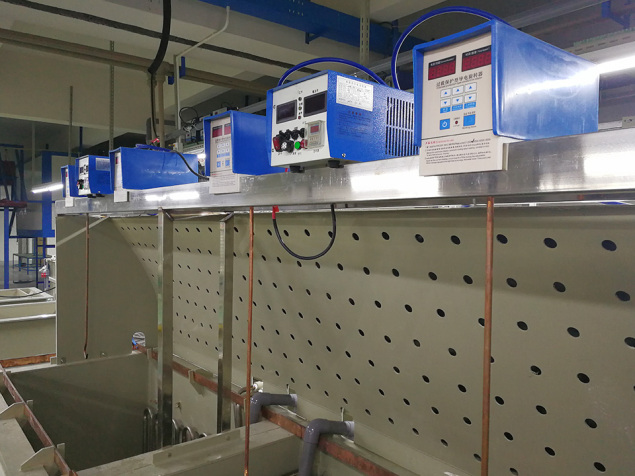Typically there are three methods of cooling methods of rectifiers, air cooling, water cooling and oil cooling. Here we introduce the advantages and disadvantages of water cooling and air cooling:
For high power DC power supply, the environment condition is not good such as with corrosive fumes, much dust, very high environment temperature, requires high IP rating, water cooling is more suitable.
Like some special environments and sub-tropical climate areas, such as electroplating, anodizing, electrolysis etc. environment, we generally recommend water cooling rectifier.
1) Water cooling Rectifier:
The heat generated by the power semiconductor components inside rectifier will be dissipated through circulated cooling water, cold water(lower than 35℃) goes into the rectifier cooling loop and get hoter water out, through this circulation, the heat is dissipated to keep the rectifier running normally.

Advantages of water cooling:
A. Less maintenance needed, no need to change cooling fans like air cooling;
B. Rectifier with lower cost;
C. Better cooling performance under high ambient temperature, up to 50℃;
D. Better cooling effect for high power rectifier;
E. Cabinet sealed, suitable for corrosive environment;
F. Higher IP rating;
G. Low noise from rectiifer;
H. Smaller size.
Disadvantages:
Need user to provide suitable cooling water or we could provide water chiller together on request.
Cooling water quality requirement:
Better to provide purified deioned water for the rectifier, especially for high voltage rectifiers.
If could not provide deioned water, the water quality must meet below requirement:
Item
Value
Remarks
Water quality
PH: 6~8
Resistivity ≥20KΩcm
Hardness<8 dH
Particle≤0.25mm
Suspended solid≤30mg/L
Water is not corrosive, dirty
Does not contain acids or salt
Inlet Water Temperature
20-35℃
To prevent condensation, the water must not be too cold. The ideal temperature is between ambient temperature and 35℃(not below dew point)
Inlet Water Pressure
0.3MPa-0.5MPa
Water flow
According to rectifier power, the inlet water and outlet water temperature difference is 5℃-10℃.
Connection of Cooling Water:
Use adaptive cooling water pipe and connectors to connect to the inlet and outlet interface on the rectifier. Below pictures are for example:
2) Forced air cooling Rectifier:
Advantages:
A. Convenient use, needn't extra work on the cooling system;
B. Suitable for low power rectifier
Disadvantages:
A. In most conditions, price is higher than water cooling.
B. Cooling performance is not as good as water cooling under very high ambient temperature above 40℃.
C. Higher noise from the rectifier.
D. The IP rating is lower, because of heat exhange between rectiifer inside and outside, the corrosive fumes and dusts may enter the rectifier and will shorten the
lifespan of the fans and other parts.
E. Need more maintenance work for the dust clearance.
F. Because the cooling fans are mechanical parts, after some years, they need to be replaced.
G. Bigger size than water cooling rectifier.
If users prefer to air cooing for corrosive applications, we recommend rectifiers put in a separate area or room isolated from the plating cells to avoid corrosion and dust. Like the picture:
Cooling is crucial for maintaining the proper functioning and longevity of rectifiers, especially when they are subjected to high loads or continuous operation. There are several methods used to cool rectifiers:
Air Cooling:
Forced Air: Fans or blowers are used to circulate air around the rectifier components, dissipating heat. This method is cost-effective and relatively simple.
Natural Convection: Utilizes the surrounding air's natural movement to cool the rectifier. It doesn’t involve additional fans or blowers and can be effective for smaller or less heat-intensive rectifiers.
Liquid Cooling:
Liquid Immersion: Submerging the rectifier in a dielectric liquid (like mineral oil or specialized coolants) that efficiently conducts heat away from the components. It provides effective cooling and can accommodate higher power densities.
Liquid Circulation: Coolant flows through channels or heat exchangers integrated into the rectifier, absorbing heat and then circulating away to dissipate it elsewhere, often using external radiators or heat sinks.
Heat Sinks:
Heat sinks are passive cooling devices that increase the surface area available for heat dissipation. They are typically made of materials like aluminum or copper and can be combined with other cooling methods for enhanced efficiency.
Thermal Management Systems:
Integrated thermal sensors and control systems monitor the rectifier's temperature and adjust cooling mechanisms accordingly. This ensures optimal cooling while preventing overheating.
The choice of cooling method often depends on various factors:
Power Density: Higher power rectifiers may require more sophisticated cooling methods like liquid cooling to manage the heat effectively.
Space and Environment: Air cooling might be preferred when space is limited or when the rectifier is located in environments where liquid cooling isn't practical or safe.
Cost and Efficiency: Different cooling methods have varying costs and efficiencies. Air cooling is generally more cost-effective, while liquid cooling might offer better efficiency for high-power applications.
Each cooling method has its advantages and limitations, and the selection depends on the specific requirements, power ratings, space constraints, and environmental factors surrounding the rectifier system.
With our great management, potent technical capability and strict excellent handle procedure, we continue on to provide our customers with reputable top quality, reasonable selling prices and great providers. We purpose at becoming amongst your most trusted partners and earning your satisfaction for Igbt Rectifier Supplier,Air Cooling Rectifier Supplier,Dc Power Supply Rectifier Exporter,Electroplating Rectifier For Sale,Direct Current Rectifier Supplier,1000a Dc Power Supply,Electroplating Rectifier For Sale,500a High Frequency Rectifier,Surface Treatment Equipment Project
Previous: The Complete Guide To Drill Rods
Copyright:@2020-2021
Comments Please sign in or sign up to post.
0
0 of 500 characters used